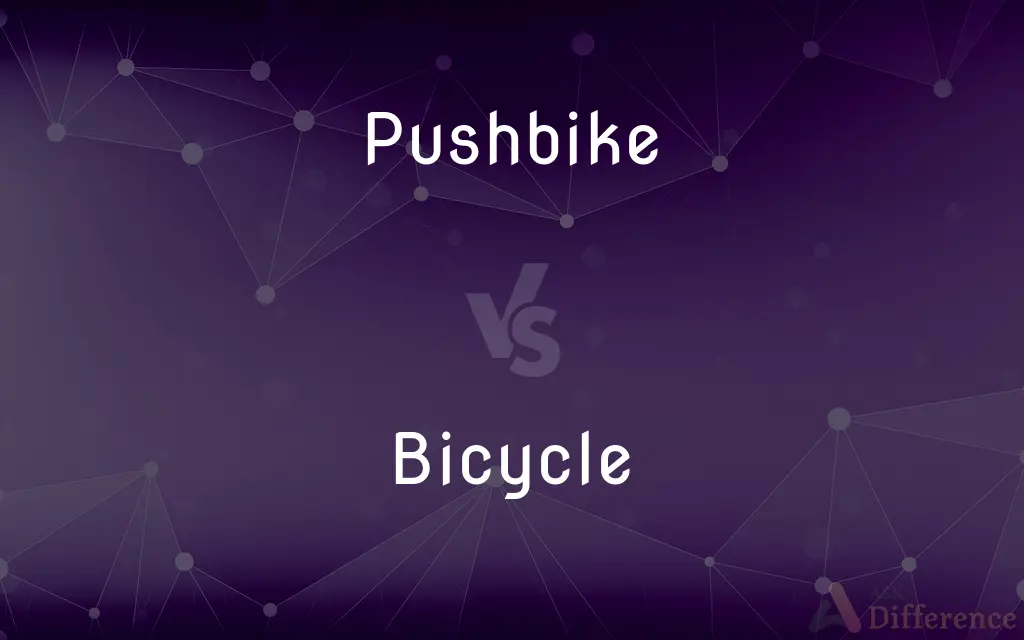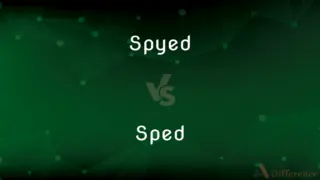Pushbike vs. Bicycle — What's the Difference?
By Tayyaba Rehman & Maham Liaqat — Updated on March 12, 2024
A pushbike, propelled by pushing feet against the ground, primarily refers to children's bikes without pedals. A bicycle requires pedaling to move, suitable for all ages, featuring a chain-driven mechanism.

Difference Between Pushbike and Bicycle
Table of Contents
ADVERTISEMENT
Key Differences
Pushbikes, often synonymous with balance bikes, are designed for young children to develop balance and steering skills. They lack pedals and gears, requiring riders to push off the ground with their feet to move forward. On the other hand, bicycles are equipped with pedals and a chain-driven mechanism, allowing riders to cover longer distances efficiently without continuous ground contact.
The design of pushbikes focuses on simplicity and safety, featuring a low frame for easy mounting and dismounting, which is ideal for toddlers and young children learning to ride. Bicycles, however, come in various designs and sizes tailored to different ages, skill levels, and riding conditions, from casual riding to competitive cycling.
Pushbikes serve as an introductory tool to bicycling, emphasizing balance and control without the complexity of pedaling. This contrasts with bicycles, where learning to balance is coupled with mastering pedaling, requiring a higher coordination level from the outset.
While pushbikes typically have a limited speed due to the push-and-glide motion, bicycles can achieve much higher speeds, thanks to the mechanical advantage provided by gears and pedals. This makes bicycles more suitable for commuting and sport.
In terms of physical exertion, pushbikes rely on short bursts of effort from pushing, which can be less continuous compared to the sustained effort required to pedal a bicycle. This distinction highlights how each vehicle caters to different developmental stages and physical capabilities.
ADVERTISEMENT
Comparison Chart
Propulsion Method
Pushing feet against the ground.
Pedaling with legs.
Age Group
Primarily for toddlers and young children.
Suitable for all ages.
Design Features
No pedals or gears, low frame.
Various designs with pedals, gears, and sized frames.
Purpose
Develop balance and steering skills.
Transportation, recreation, and competitive cycling.
Speed
Limited by push-and-glide motion.
Higher speeds achievable through pedaling.
Learning Focus
Balancing and steering without pedaling.
Balancing, steering, and pedaling coordination.
Suitability
Introductory riding tool.
Comprehensive transportation and sport option.
Physical Exertion
Short bursts of effort from pushing.
Sustained effort through continuous pedaling.
Compare with Definitions
Pushbike
A bike without pedals for developing balance.
The toddler enjoyed gliding on his pushbike at the park.
Bicycle
Requires coordination of pedaling and steering.
Learning to pedal and steer her bicycle was an exciting challenge.
Pushbike
Features a simple, pedal-less design.
The pushbike's simplicity made it easy for him to learn to ride.
Bicycle
Suitable for transportation and sport.
Competing in bicycle races became his newfound passion.
Pushbike
Encourages early cycling skills.
Riding a pushbike can improve a child's confidence and balance for future cycling.
Bicycle
Offers a wide range of designs for all ages.
They found bicycles suitable for the entire family at the local shop.
Pushbike
Designed for beginners, especially children.
Her first pushbike helped her learn how to balance.
Bicycle
A two-wheeled vehicle powered by pedaling.
She rode her bicycle to work every day for exercise.
Pushbike
Operated by pushing feet against the ground.
He quickly moved forward by pushing his feet on the ground while on his pushbike.
Bicycle
Features pedals and gears for various speeds.
His new bicycle had multiple gears for different terrains.
Pushbike
A pedal bicycle, as distinguished from a motorized bicycle.
Push bicycle
Bicycle
A bicycle, also called a bike or cycle, is a human-powered or motor-powered, pedal-driven, single-track vehicle, having two wheels attached to a frame, one behind the other. A bicycle rider is called a cyclist, or bicyclist.
Pushbike
To travel by pushbike.
Bicycle
A vehicle consisting of a light frame mounted on two typically wire-spoked wheels one behind the other and usually having a seat, handlebars for steering, brakes, and two pedals by which it is driven.
Bicycle
An exercise bicycle.
Bicycle
To ride or travel on a bicycle.
Bicycle
A vehicle that has two wheels, one behind the other, a steering handle, and a saddle seat or seats and is usually propelled by the action of a rider’s feet upon pedals.
Bicycle
A traveling block used on a cable in skidding logs.
Bicycle
The best possible hand in lowball.
Bicycle
A motorbike.
Bicycle
A slut; a promiscuous woman.
Bicycle
(climbing) A stabilizing technique in which one foot is pushed down while the other is pulled up.
Bicycle
(ambitransitive) To travel or exercise using a bicycle.
Bicycle
To physically ship (a recorded programme) to another broadcasting entity.
Bicycle
A light vehicle having two wheels one behind the other. It has a saddle seat and is propelled by the rider's feet acting on cranks or levers.
Bicycle
A wheeled vehicle that has two wheels and is moved by foot pedals
Bicycle
Ride a bicycle
Common Curiosities
Are bicycles safer than pushbikes?
Safety depends more on the rider's skill and the riding environment than the type of bike. However, bicycles allow for more control at higher speeds with brakes and gears.
How does riding a pushbike prepare a child for a bicycle?
Riding a pushbike helps a child develop balance and steering skills, making the transition to pedaling on a bicycle smoother.
Do pushbikes have brakes?
Some pushbikes come with handbrakes, but many rely on the child's feet for stopping.
What is the main difference between a pushbike and a bicycle?
The main difference is that pushbikes are propelled by pushing feet against the ground and lack pedals, while bicycles are propelled by pedaling.
Can you add pedals to a pushbike?
Most pushbikes are not designed to have pedals added; transitioning to a bicycle is recommended once a child has mastered the pushbike.
At what age should a child transition from a pushbike to a bicycle?
Children often transition from pushbikes to bicycles around the age of 3 to 6 years, depending on their balance and coordination skills.
Why do bicycles have different wheel sizes?
Different wheel sizes can affect the bicycle's speed, stability, and maneuverability, catering to various riding styles and rider heights.
Can elder person use pushbikes?
Pushbikes are primarily designed for children, though people may use adult-sized balance bikes for special learning needs or rehabilitation.
What types of bicycles are there?
There are many types, including road, mountain, hybrid, and touring bicycles, each designed for specific riding conditions and needs.
Which is better for exercise, a pushbike or a bicycle?
Bicycles offer better exercise opportunities due to the continuous pedaling motion, which can engage more muscle groups and improve cardiovascular health.
How do gears affect a bicycle's performance?
Gears allow for adjustments in pedaling resistance, making it easier to ride over varied terrain and maintain speed.
How do I choose between a pushbike and a bicycle for my child?
Consider the child's age, balance skills, and readiness to pedal. Pushbikes are great for beginners, while bicycles are the next step for children ready to pedal.
Can pushbikes be used indoors?
Yes, pushbikes can be used indoors, especially those with non-marking tires, making them suitable for young children to practice on.
Can pushbikes help with a child's physical development?
Yes, pushbikes promote physical development by improving balance, coordination, and motor skills in children.
Are pushbikes more affordable than bicycles?
Pushbikes can be more affordable due to their simpler design and lack of mechanical parts like gears and pedals.
Share Your Discovery

Previous Comparison
Spyed vs. Sped
Next Comparison
Innie vs. OutieAuthor Spotlight
Written by
Tayyaba RehmanTayyaba Rehman is a distinguished writer, currently serving as a primary contributor to askdifference.com. As a researcher in semantics and etymology, Tayyaba's passion for the complexity of languages and their distinctions has found a perfect home on the platform. Tayyaba delves into the intricacies of language, distinguishing between commonly confused words and phrases, thereby providing clarity for readers worldwide.
Co-written by
Maham Liaqat













































